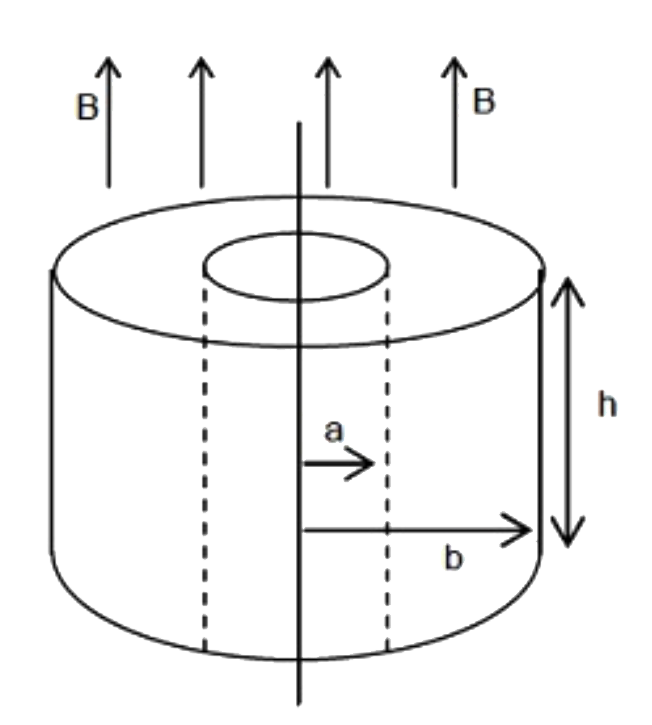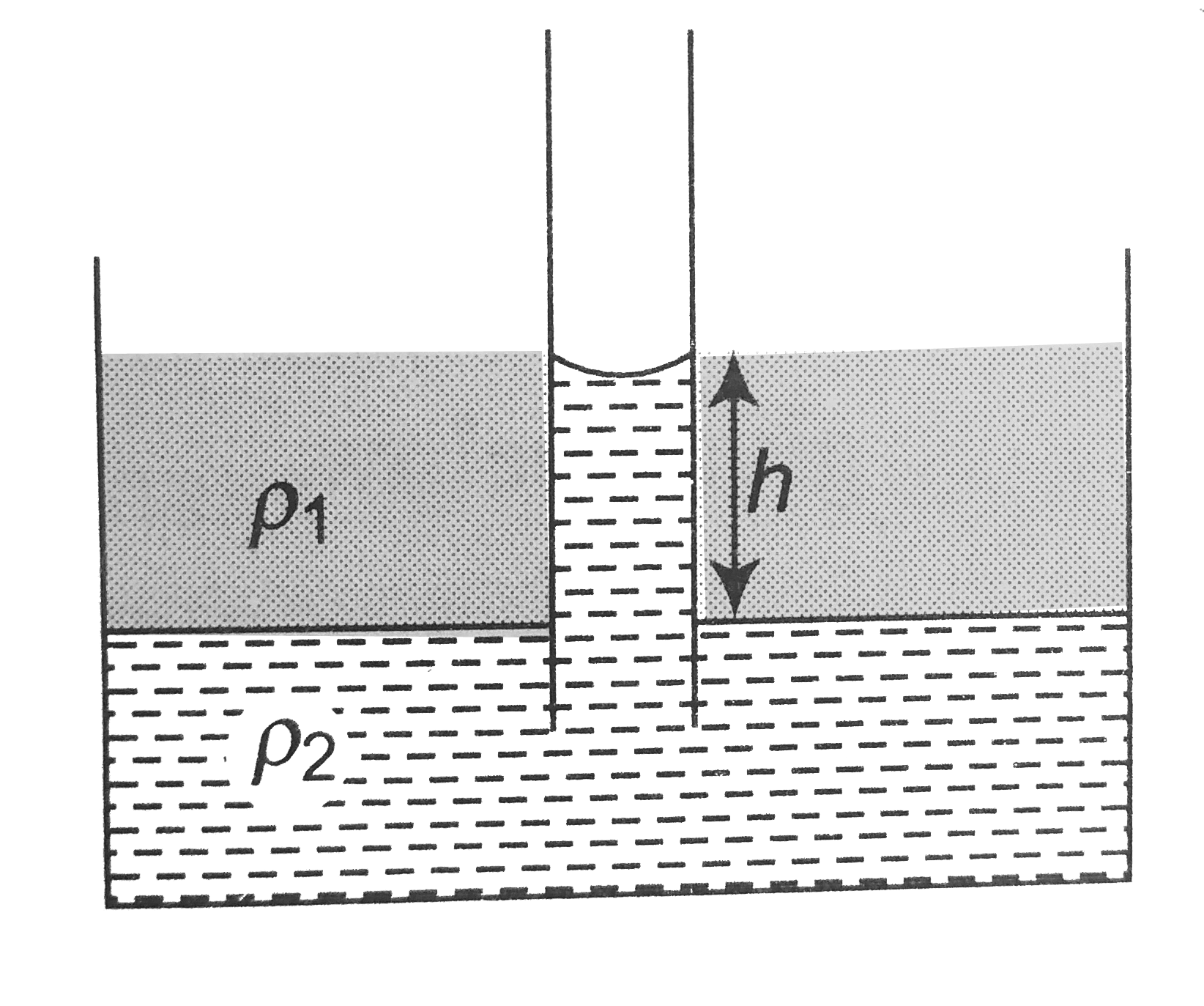Two long coaxial cylindrical metal tubes (inner radius a, outer radius b) stand vertically in a tank of dielectric oil (of mass density ρ , dielectric constant K). The inner one is maintained at potential V and the outer one is grounded. To what equilibrium height (h) does the oil rise in the space between the tubes? [Assume this height ( h) as an equilibrium height]
ε02V2(K−1)gρ(b2−a2)1n(ba)
ε02V2(K−1)ρ(b2−a2)g1n(ba)
4ε02V2(K−1)gρ(b2−a2)1n(ba)
6ε02V2(K−1)ρ(b2−a2)g1n(ba)
The correct Answer is:B
To solve the problem of determining the equilibrium height (h) to which the oil rises in the space between two coaxial cylindrical tubes, we can follow these steps:
Step 1: Understand the System
We have two coaxial cylindrical tubes: an inner tube with radius a and an outer tube with radius b. The inner tube is maintained at a potential V, while the outer tube is grounded (potential = 0). The space between the tubes is filled with dielectric oil of mass density ρ and dielectric constant K.
Step 2: Determine the Capacitance
The capacitance C of a cylindrical capacitor filled with a dielectric can be expressed as:
C=2πϵ0ϵrLln(b/a)
where ϵr=K (the dielectric constant of the oil), and L is the length of the cylinders.
Step 3: Calculate the Electric Field
The electric field E in the region between the two cylinders can be calculated using the relationship between potential difference and electric field:
E=Vd
where d is the distance between the two cylinders, which is b−a.
Step 4: Force on the Dielectric
The force acting on the dielectric oil due to the electric field can be expressed as:
F=12ϵE2A
where A is the cross-sectional area of the inner cylinder, given by A=πa2.
Step 5: Weight of the Oil
The weight of the oil column of height h is given by:
W=ρgVo
where Vo is the volume of oil, Vo=A⋅h=πa2h.
Step 6: Equilibrium Condition
At equilibrium, the upward electric force must balance the weight of the oil:
12ϵE2A=ρg⋅πa2h
Step 7: Substitute and Rearrange
Substituting E and A into the equilibrium condition:
12⋅ϵ0K⋅(Vln(b/a))2⋅πa2=ρg⋅πa2h
We can cancel πa2 from both sides:
12⋅ϵ0K⋅(Vln(b/a))2=ρgh
Step 8: Solve for Height h
Rearranging gives us:
h=ϵ0K⋅V22ρg⋅ln(b/a)
Final Answer
Thus, the equilibrium height h to which the oil rises is:
h=ϵ0K⋅V22ρg⋅ln(b/a)
We have two coaxial cylindrical tubes: an inner tube with radius a and an outer tube with radius b. The inner tube is maintained at a potential V, while the outer tube is grounded (potential = 0). The space between the tubes is filled with dielectric oil of mass density ρ and dielectric constant K.
The capacitance C of a cylindrical capacitor filled with a dielectric can be expressed as:
C=2πϵ0ϵrLln(b/a)
where ϵr=K (the dielectric constant of the oil), and L is the length of the cylinders.
The electric field E in the region between the two cylinders can be calculated using the relationship between potential difference and electric field:
E=Vd
where d is the distance between the two cylinders, which is b−a.
The force acting on the dielectric oil due to the electric field can be expressed as:
F=12ϵE2A
where A is the cross-sectional area of the inner cylinder, given by A=πa2.
The weight of the oil column of height h is given by:
W=ρgVo
where Vo is the volume of oil, Vo=A⋅h=πa2h.
At equilibrium, the upward electric force must balance the weight of the oil:
12ϵE2A=ρg⋅πa2h
Substituting E and A into the equilibrium condition:
12⋅ϵ0K⋅(Vln(b/a))2⋅πa2=ρg⋅πa2h
We can cancel πa2 from both sides:
12⋅ϵ0K⋅(Vln(b/a))2=ρgh
Rearranging gives us:
h=ϵ0K⋅V22ρg⋅ln(b/a)
Thus, the equilibrium height h to which the oil rises is:
h=ϵ0K⋅V22ρg⋅ln(b/a)
Similar Questions
Two long coaxial and conducting cylinders of radius a and b are separated by a material of conductivity σ and a constant potential difference V is maintained between them by a battery. Then the current per unit length of the cylinder flowing from one cylinder to the other is
View SolutionA cylinderical tube of length L has inner radius a and outer radius b. What is the resistance of the tube between its inner and outer surface ? Given that the resistivity of its material is ρ.
View SolutionA coiaxial cable consists of two thin coaxial cylinders electrically connected at one end, an inner cylindrical conducting tube of radius a carrying a steady current l which is screened by an outer cylindrical conducting sheath of radius b which provides a return path. There is no dielectric medium present.
Use Ampere's theorem to derive the total magnetic energy stored in the space between the conductors, show that the inductance of a length l of the cable is
L=μ0l2πln(ba)
In this cable (a = 5 mm, b = 10 mm, l = 1000 m) is now employed in a (resistanceless) LC circuit containing a capacitance C = 1000 μF, determine the period of oscillations (neglect the capacitance of the cable itself).
View SolutionA railway track is banked for a speed v, by making the height of the outer rail h higher than that of the inner rail. The distance between the rails is d. The radius of curvature of the track is r
View SolutionA metallic spherical shell of radius r1 is surrounded by another concentric metallic spherical shell of radius r2. The space between the two shells is filled with a dielectric of dielectric constant K. If a charge Q is given to the inner shell, the charge appearing on the outer surface of the outer shell is
View SolutionA uniform capillary tube of inner radius r is dipped vertically into a beaker filled with water. The water rises to a height h in the capillary tube above the water surface in the beaker. The surface tension of water is σ. The angle of contact between water and the wall of the capillary tube is θ. Ignore the mass of water in the meniscus. Which of the following statements is (are) true?
View SolutionA conducting ring of circular cross - section with inner and outer radii a and b is made out of a material of resistivity ρ. The thickness of the ring is h. It is placed coaxially in a vertical cylindrical region of a magnetic field B=krt. Where k is a positive constant, r is the distance from the axis and t is the time. If the current through the ring is I=(khαp)[b3−a3] , then what is the value of α?

View Solution
A container is partially filled with a liquid of density ρ2 A capillary tube of radius r is vertically inserted in this liquid. Now another liquid of density ρ1(ρ1<ρ2) is slowly poured in the container to a height h as shown. There is only denser liquid in the capillary tube. The rise of denser liquid in the capillary tube is also h. Assuming zero contact angle, the surface tension of heavier liquid is
View SolutionTwo vertical cylinders are connected by a small tube at the bottom. It contains a gas at constant temperature . Initially the pistons are located at the same height. The diameters of the two cylinders are different . Outside the cylinder the space is vaccum . Gravitational acceleration is h,h0=20cm,m1=2kgandm2=1kg. The pistons are initially in equilibrium. If the masses of the piston are interchanged find the separation between the two pistons when they are again in equilibrium. Assume constant temperature .
_E01_299_Q01.png)
View SolutionFor a car taking a turn on a horizontal surface, let N1 and N2 be the normal reactions of the road on the inner and outer wheels respectively
View Solution
